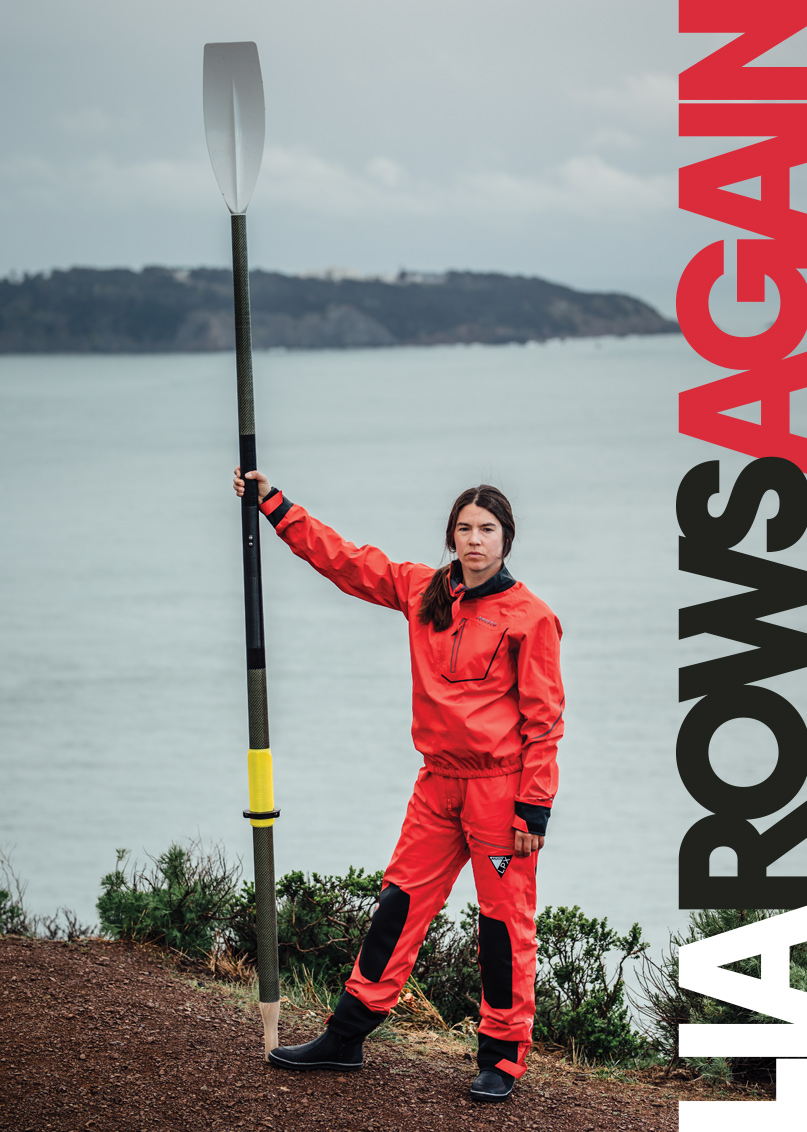
Merrily, merrily, merrily, merrily,
being a badass rower ain’t just a dream.
In the August issue of Northwest Yachting, we introduced you to Lia Ditton, a professional adventurer set on rowing her 21-foot rowboat across the North Pacific, from Japan to San Francisco. We recently caught up with Lia to get an update on her plans, and she shared some harrowing training stories, including her row from Portland to San Francisco last Fall. She tells the tale below.
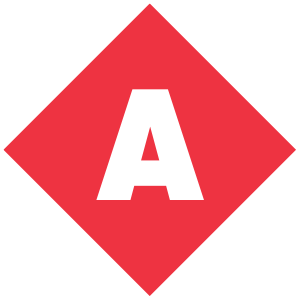 A man with a moustache looks up from the side of his boat. “Destination?” he asks.
A man with a moustache looks up from the side of his boat. “Destination?” he asks.
“Sorry, what did you say?” I reply.
“Where are you heading?” the man says, attaching a different lure to his fishing rod.
“San Francisco!” I reply.
The man’s wife leans out of the cabin, presumably to ask more questions. This exchange happens a few miles after leaving Portland, on my 100-mile row to the mouth of the Columbia River. Judging by their expressions, I might as well have just said Disneyland. Astoria became my new response. Most thought that was a long way, but everyone agreed it would be a good adventure.
And it was. I discovered the Columbia River to be an untapped haven for small boat exploration. I stayed out of the shipping lanes when possible, and took the meandering route behind the islands. Portland to Sandy Island (opposite Kalama) was one long, hot row. Anchored off Walker Island, the awakening of the day was so breathtakingly beautiful that I took many photos as the sun rose.
I left Cathlamet at fish o’clock and I could have spent days exploring the Clifton Channel, which feeds into Knappa Slough, Calendar Slough, and Prairie Channel. It was just me and fish-eating birds rowing in forgotten wilderness.
From Tongue Point onwards, I faced the might of the Columbia River. Down the river, there was nowhere to duck in. Three container ships anchored off Astoria were lit like Christmas trees, so I decided to row parallel to the ships and use them as streetlamps. Even at 4 am this turned out to be a very bad idea. There was a clap of thunder and my heart rate spiked. Anchor chain began rumbling against steel – one of the freighters was on the move.
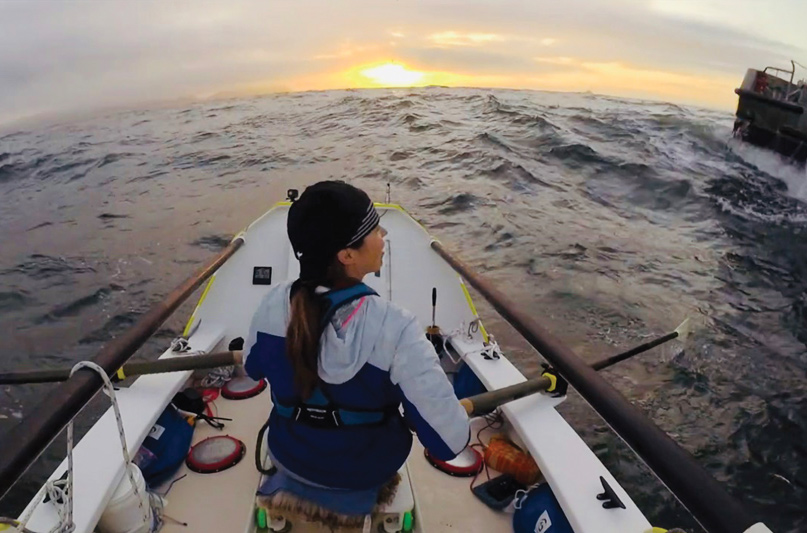
Above: A U.S. Coast Guard cutter stops by for a second time as Lia rows out to sea over the Columbia River bar. Boaters were alarmed to see a vessel without an engine and hailed the Coast Guard on the VHF.
Beyond the Astoria Bridge, there were no lights. The sea and sky were black with no distinction. Wisps of fog like clouds of dry ice engulfed my boat. I rowed on through the fog banks, fighting a rising sense of panic.
My dot on the Navionics boating app had me in the Columbia River, but it was so hard to correlate this information with what I could see. “It’s going to be OK,” I kept telling myself. “Even if you are heading out to sea, you have everything you need.”
Daylight finally began to break, and the fog shifted to reveal the marker for Hammond Marina. The tide was about to turn. I was anxious I wouldn’t reach the inlet in time. Then I was anxious I was going to overshoot. I started rowing perpendicular to the breakwater and then rowed hard to make the gap into the harbor. Everyone stopped and stared.
But after six days rowing a strange-looking boat down the river, I was pretty used to stares!
Today, they have a standard hull mold once again and are working on one to two boats a year. Only now, those boats have twin 65’ hulls, can carry 49 passengers, and are as wide as a tennis court. The new builds have something else in common with their historic production of offshore keelboats—their recent launches have also sailed to Hawaii, not in a race, but on delivery to their homeports in the islands.
It was now Labor Day weekend, and fishing boats streamed out of the harbor towards the Columbia River Bar. “What the hell are you thinking?” a fisherman shouts as he opens throttle to pass me. “You’re a brave soul!”
My speed over ground accelerates until the tide is spitting me out at 8.75 knots! Huge, silvery waves roll over the Columbia River bar. I go up and down the rollercoaster waves, as the conveyor belt draws me out. A ship heading outbound is followed by a tanker heading inbound, forcing me west over a patch of 30 feet.
Twice the U.S. Coast Guard cutter comes by, radioed by boats alarmed at the mere sight of seeing a human powered vessel on the bar. I row hard to avoid the vortex around channel markers and struggle to keep my breakfast down from the stress of being interrogated.
The relief of being out in open ocean is short-lived. As night falls, I find myself surrounded by fishing trawlers. Fishing trawlers are the worst kind of traffic, as they drag lines for several feet, change direction without warning, and may not be attentive at the helm. For the first three nights, sleep is sporadic.
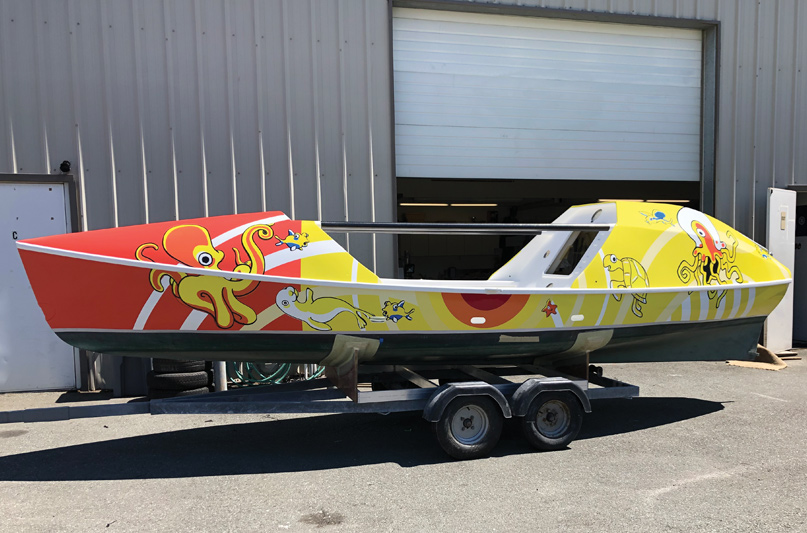
It was now Labor Day weekend, and fishing boats streamed out of the harbor towards the Columbia River Bar. “What the hell are you thinking?” a fisherman shouts as he opens throttle to pass me. “You’re a brave soul!”
My speed over ground accelerates until the tide is spitting me out at 8.75 knots! Huge, silvery waves roll over the Columbia River bar. I go up and down the rollercoaster waves, as the conveyor belt draws me out. A ship heading outbound is followed by a tanker heading inbound, forcing me west over a patch of 30 feet.
Twice the U.S. Coast Guard cutter comes by, radioed by boats alarmed at the mere sight of seeing a human powered vessel on the bar. I row hard to avoid the vortex around channel markers and struggle to keep my breakfast down from the stress of being interrogated.
The relief of being out in open ocean is short-lived. As night falls, I find myself surrounded by fishing trawlers. Fishing trawlers are the worst kind of traffic, as they drag lines for several feet, change direction without warning, and may not be attentive at the helm. For the first three nights, sleep is sporadic.
Off the Continental Shelf and away from most of the trawlers, I discover there are new things to be afraid of. For a whole afternoon, three 10-foot blue sharks swim under and around my boat. In the evening, the sharks are still with me. In fact, for four days I have shark company. How do I feel about this? I decide the best way to cope is to talk to them! “I am sorry about the toothpaste juice,” I say before spitting over the side. “It’s Tom’s from Maine. Ingredients are organic. Maybe you’ve been to Maine?” My foot catches the handle of an oar and I jump out of my skin. I laugh at myself. Coping well, huh?
Lying in my bunk, I realize I am about to try and sleep with an actual shark under my bed. This inspires me to start writing a new children’s book titled, The Shark Under My Bed. It goes like this:
Child: There’s a shark under my bed.
Adult: What is the shark doing under your bed?
Child: He’s eating fish.
Adult: What kind of fish?
Child: Tuna fish.
I fall asleep.
One fishing trawler then another think my boat is adrift (and up for salvage). Both encounters are terrifying as the boats charge at me without responding to the radio, and the crew are wearing ski masks to protect their faces from the wind. Another day, I watch a USCG helicopter fly a search pattern until they’re doing circles overhead, and I’m on the radio shouting over the din trying to establish if anyone has sent them or if they’re just out on patrol. They saw me on AIS and were just out on patrol.
Windless, sunny days follow and I begin to find my rhythm among the glittery blue. Except when I stop rowing, something strange happens. I drift all over the place and realize I’m caught in a northerly current, worse, it’s a counter-clockwise eddy (west of Eugene) from which the escape route is unknown. I have no idea how far south or west or east I need to row to get out of it. Finally with the help from a professor from Oregon State University, I’m advised to row northwest. Northwest!? Against the prevailing wind!?
Once free of the eddy, I’m under siege from squalls. The sky is peppered with grey sacks with streaks running to the horizon. In between cloudbursts, there are rainbows and great white sharks launching clean out of the water. I watch one shark materialize like a vertical missile from the deep, its prey dangling from its jaws.
At the Oregon-California border, I am on sea anchor wedged inside my cabin listening to what sounds like my boat being gradually ripped apart. After five hours, the worst of the storm is finally over. When the wind eases, I pop out on deck to find a U.S. aircraft carrier standing by. AN AIRCRAFT CARRIER!
I imagine the conversation onboard the carrier went something like this: “A person has emerged on deck and it’s a woman!” In an instant, the aircraft carrier is gone!
I wait for days for the wind to clock to the northwest, so I can make progress south again. The swells are monstrous and in the troughs, I have zero visibility. This could be heaven or this could be hell. I play the song “Hotel California” by the Eagles, and monitor the AIS for ships.
In a small rowboat, I like to see the backs of ships when they are passing close by. So, imagine my shock when I step on deck for a routine stern-check to see the bow of a tanker a mere 0.7 miles away! My legs shook violently as I lunged for the radio. “What happened?!” I ask the captain “We were set to pass with 3 nautical miles between us!” He replied, “We just don’t see much out here, so when we saw you, we diverted to have a closer look.”
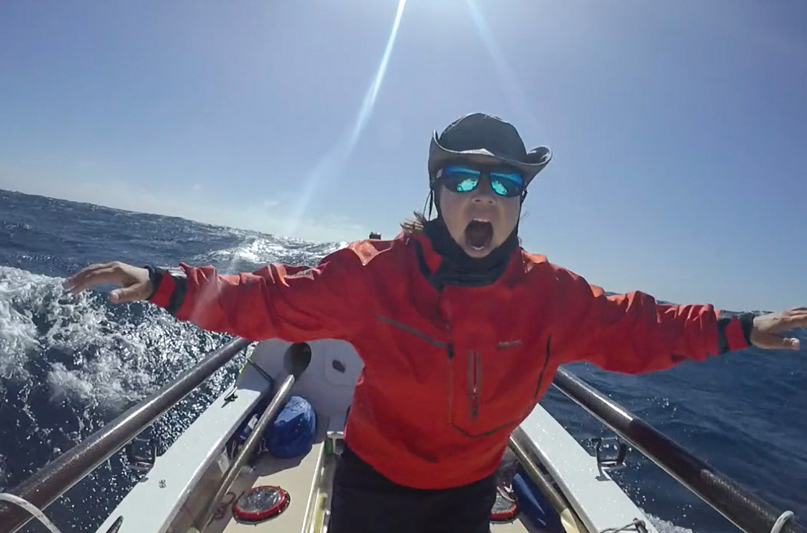
I wait for days for the wind to clock to the northwest, so I can make progress south again. The swells are monstrous and in the troughs, I have zero visibility. This could be heaven or this could be hell. I play the song “Hotel California” by the Eagles, and monitor the AIS for ships.
In a small rowboat, I like to see the backs of ships when they are passing close by. So, imagine my shock when I step on deck for a routine stern-check to see the bow of a tanker a mere 0.7 miles away! My legs shook violently as I lunged for the radio. “What happened?!” I ask the captain “We were set to pass with 3 nautical miles between us!” He replied, “We just don’t see much out here, so when we saw you, we diverted to have a closer look.”
I try and keep calm. “You’re bearing down on me,” I said. “But we haven’t seen you yet. Oh wait. Now we see you!” he says.
Back at the oars, a week of gale force winds stretches ahead of me. I began covering 60 miles per day in my 21-foot rowboat! With the North Pacific high-pressure system pressed against the West Coast, the wind ratchets up into the high 30s and low 40s and at times, the waves are frenzied white peaks all around me.
During the night, waves crash into the side of my boat and swamp the deck. I jump up and pump the hand bilge pump. I bail on and off through the hours of darkness as I don’t have the solar power to use my electric bilge pump at night. As the sea state worsens, I change my thinking and allow the cockpit to remain flooded. I want the weight. In fact, I want more weight and preferably in the stern.
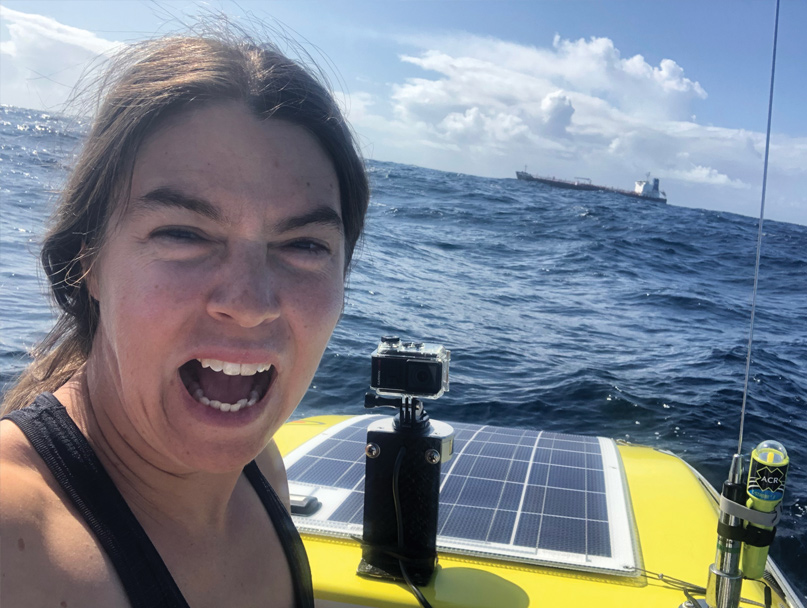
To reach land, I had to cross the Continental Shelf. Cross the shelf in breaking seas in 40 knots of wind, you’d have to be out of your mind! What kind of horror show is this going to be?
Every day, I row east and perpendicular to the waves. A foul wave could break an oar, or worse, an arm. Sometimes, I blast music to distract myself and pretend that, “this is just a normal day!” I have plenty of food and am safe. I could remain at sea for days. I could wait for the weather to abate. My friends on shore encourage me to head towards land.
Reluctantly, I turn my boat east to cross the Continental Shelf. I row watching the depth sounder chart my path towards land, as the waves roar towards me in great cascades. The setting sun presses against the horizon. There’s so much water flying around, the atmosphere is an apocalyptic rosy haze.
In order to stay off Cordell Bank (150 feet compared to the 10,000 feet of the Continental Shelf), I calculate that I need to row non-stop through the night. I close my eyes and try to row blind between breaking waves. Impossible! Foolish even to try! I head back out to sea as fast as I can. Can I clear the west side of the bank? Have I left too late? I row for my life. I row with everything I can give, and then when the night is pitch black and I can row no more, I sink to my knees and pray.
I skirt the bank. Miraculously the wind switches off, and I wake up shivering and sore. I remember being knocked down, the boat side-slammed by a white wall of water. Exhausted, I tell my friends onshore that I just can’t make San Francisco. “I can’t do it. Let’s aim for Monterey instead.” But after four hours of sleep, I change my mind. “What is wrong with you, Lia?” I ask myself. “Why don’t you ever quit?” For the next two days, I row 25-30 mile days, rowing for twelve hours non-stop. The human body is amazing.
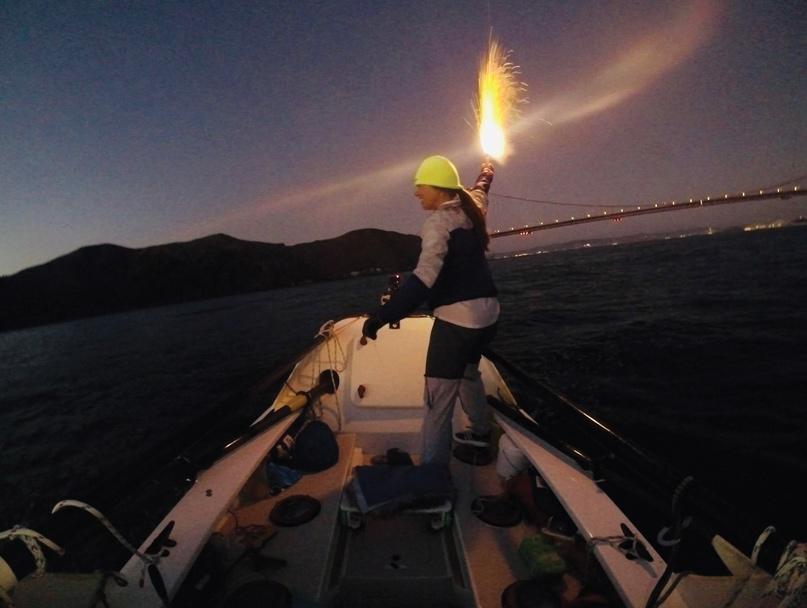
And finally, after 24 days, there it is: The Golden Gate Bridge’s south tower looms before me with its support arms stretching across the middle. I expect to cry. Instead I am overjoyed. I soak in the familiar sound of the horn off Point Diablo, the rumble of traffic over the bridge, and as I turn the corner into the bay, I can hardly believe what I have just endured.
The interviewer is a young woman and she stands on the dock unmoving, looking bewitched with a half smile on her face. She’s clutching a piece of paper with questions, but she doesn’t lift the paper once. Nor does she ask a single question.
Fortunately, I haven’t spoken to anyone in almost a month, so I jabber away. I wonder what the young woman is thinking, but I sort of know. She’s thinking about my adventure in the context of her own life. It’s a wonderful memory for me, this look of hers, because if you can inspire even one person in a positive way, I’d say that what you do might just be worthwhile.
Read the print version on Issuu